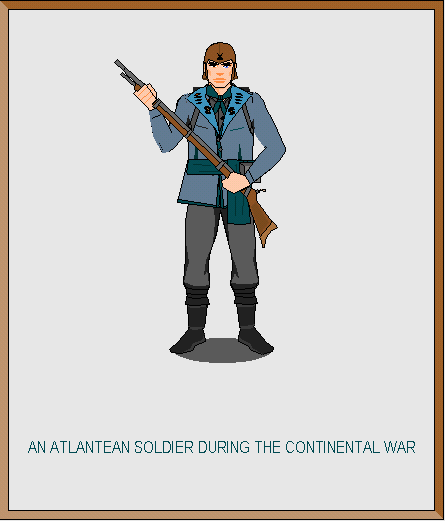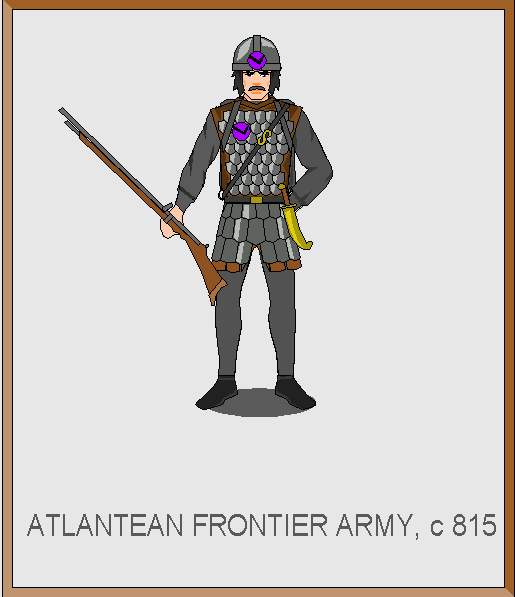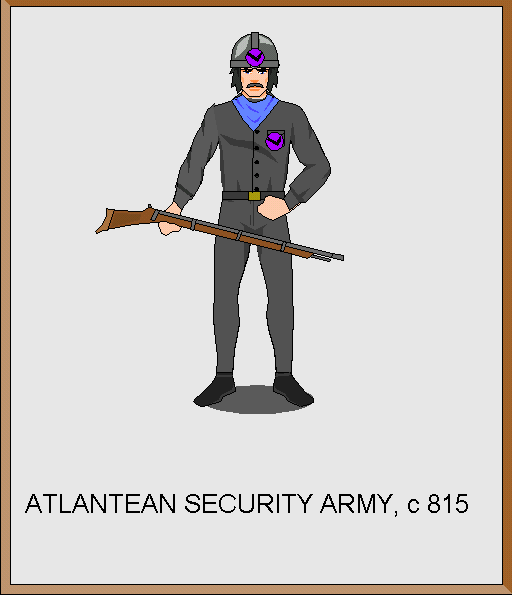|
Home Page
Discovery of Atlantis
First Empire-(1) to 261
Second Empire- (1) 361 - 409 |
| The
Army from the Great Continental War to the final defeat of Atlantis, 743
– 890
THE ARMY DURING THE GREAT CONTINENTAL WAR The Atlantean Army, its organisation, weaponry and tactics, changed radically during the great conflict of 743 to 750. The overall size of the armed forces was tremendously increased, to defend the empire against all her enemies. Full conscription since 745 meant that she could field forces of over 1110000 men in 747, rising to a maximum in 748 of 1400000. Individual armies (PUEGGISIX), which had numbered 26 in 743, roughly two per Province, reached 40 by 746. They were usually grouped into Army Groups (BORPUEGGISIX), each with 3 to 7 Armies. The PUEGGISIX, about 24000 strong in 743, were divided into 4 CENNDARCOYIX, (literally "NEW THIRDS"), which were rechristened as THEINULPUEGGISIX (literally "QUARTER ARMIES") in 746, later simply THEINUIX (or "QUARTERS"). Also another unit was created between those of THEINUIX (5000) and PUONDIX (480). This was the DARCOYO of 1200, while the PUONDIX were reduced in size to about 200. In 749 these DARCOYIX were also given new names – OCHOSSIX, as a deliberate reminder of Second Empire times. Units became disassociated from the Provinces in which they were raised. The traditional naming of each Army according to its region of origin was done away with, and by 746, all units were known by a simple number. Cavalry were also reorganised, and new, larger, independent cavalry armies were created after 746, to carry out wide manoeuvres and make the rapid advances, which were such a feature of the later stages of the war, compared with the trench-bound middle years. Thus pistol-armed, cavalry THEINUIX, of 4000 –5000 men appeared, ultimately under the control only of the BORPUEGGIS. They were then often combined into cavalry PUEGGISIX.
Changes in tactics and weaponry by 750 were considerable compared with 743. Initially, the forces with the better weapons inevitably overwhelmed their weaker opponent, as the Basquecs did against the Atlanteans in the first year of the war. But as all sides gradually armed themselves with similar breech-loading rifles and artillery, it became more and more difficult to succeed in head-on, frontal assaults, And the defensive seemed to be gaining the advantage. This is particularly noticeable in the static fighting around Cennatlantis in 745-746. However, tactics changed accordingly: infantry formations grew looser. Men spread out more, and skirmishers were used more consistently. Generals tried to gain the advantage using turning movements, outflanking their opponents. They (especially now the Atlanteans) made use of the new, large, wide-ranging cavalry armies to sweep round the rear of the enemy. Finally transport and support were built up, using horse-power, transport on sea, lake and canal, and on a small scale, steam-powered vehicles. ORGANISATIONAL DEVELOPMENTS DURING THE FOURTH EMPIRE As the need for huge forces vanished after 750, and the Empire returned to relative peace, the size of the armed forces was slashed, from 1400000 in 747 to around 680000 by 752. This was gradually increased as the decades passed, and more wars had to be fought, and by 7995, at the time of the Southern Revolt and war with Rabarrieh, it had reached 880000. Nevertheless, conscription was dropped and throughout the Fourth Empire, the Army was a voluntary force. In structure, it remained basically as it had been in 750, and the whole Army was divided permanently into six Fronts. Each of these defended against different neighbouring countries. Northern against Skallandieh and Keltish rebellion; Eastern against the Ughans; South-Eastern against the Basquecs; Southern against Rabarrieh; North-Western to cover Phonaria and relations with Yciel Atlantis and Naomandix; and Central, a reserve in the Provinces around Cennatlantis and Atlantis. Each of these consisted of a number of Borpueggisix. Recruitment areas reverted to the areas in which Pueggisix were posted. Cavalry Pueggisix were linked to areas rather than Borpueggisix. The organisation was overseen at the top by the Emperor. A Commander-in-Chief was responsible to him, and under him came the Grand Generals for each administrative area or Front, and then the Generals of the Borpueggisix. (Note: After the spelling reforms of 760, several of these military units were written somewhat differently, e.g. FEGGIS for PUEGGIS, FOND for PUOND, FEGGISSIX as plural of FEGGIS, not FEGGISIX. We shall recognise these changes for the rest of this article.) The ban on new inventions imposed under the Third Empire had disappeared during the Continental War and remained a dead letter throughout the Fourth Empire. The standard infantry firearm was the single-action breech-loading rifle until the 770s, when magazine rifles were introduced. Machine-guns were first used in the 790s, and allocated to Ochossix after 800. There was increasing use of steam-power throughout this period. Steam transport on roads replaced horsepower, as did railways after the 770s. Steam-driven armoured vehicles, or tanks, had been used in a primitive form in the 650s and 660s, but they were then banned throughout the 3rd Empire. They were reintroduced after 780, and were initially placed with the cavalry under the cavalry Feggis. After 800, they became independent of the cavalry, and centralised under Borfeggissix in groups of ten, i.e. Doulix. They were then loosely attached to infantry Theinuix. After 795 electrical semaphore was invented, though mechanical semaphore had been in general use since the 400s. WARS OF THE FOURTH EMPIRE, AND THE CHANGES IN TACTICS The Atlantean Army was involved in several different wars during the Fourth Empire, the first two of which were entirely fought out in neighbouring countries. These were the Basquec Civil War in the 760s, and the Ughan Civil War in the 770s. These were followed by the War against Rabarrieh after 792, much of which too place in the southern parts of the Empire. Each of these Wars saw changes in weaponry and tactics which affected all the armies taking part. Atlantean involvement in the Basquec Civil War began in 765 and ended a few years later in 768, although other countries also took part for different periods within the 760s. It was a war fought by all participants with small armies, and distances and terrain made co-ordinated operations difficult. The infantry of most participants, including of course Atlantis, were now armed with rifles, although the armies of some of the smaller countries involved still used crossbows. Cavalry forces were found most useful by Atlantis, and these were now always armed with pistols and swords. Steam-powered vehicles were used for supply, to some extent, although they had problems moving in some of the more trackless areas of Basquecieh. Rivers and canals were well-developed in the country, however, and Atlantis made much use of steamships for supply and combat, as well as mines and minelayers to deter enemies. From 774 to 781, Atlantis was involved, again with various other countries, in the Ughan Civil War. This was fought somewhat similarly to the Basquec Civil War, again involving quite small forces spread out over very large distances. By this time, all participants used rifles, and Atlantis made increasing use of the magazine rifle, which had entered service there just after 770. Other countries adopted it during the 770s and 780s. Cavalry was less popular here, as the terrain in which the fighting took place was more mountainous that it had been in the previous war. In fact the wide-ranging and fast-moving manoeuvres of the Basquec War were largely replaced by more defensive fighting, with a lot of sieges or blockades of towns. Steam-power was increasingly used for transporting infantry, and within Atlantis, at least, the invention of railways after 770 speeded up this travel. The war also saw some more tentative use of steam tanks, though to little effect. The Southern Revolt began in 792, and this led to full-scale war with Rabarrieh after 798, which lasted on till the time of the Tyrants. During the Fourth Empire, the fighting remained relatively small-scale, but very different to that of the preceding two wars. For one thing the combat was within Atlantis’s own borders; also it involved guerrilla-type fighting in urban or semi-urban environments. The Rabarrans made use, at first, of small guerrilla forces, which moved quickly about the countryside, attacking poorly defended towns and villages, often with the support of sympathetic militias within those settlements. The Atlanteans were forced into defensive positions, usually small forts, frequently defended by machine-guns, and also barbed wire and minefields. Both sides made considerable use of cavalry and even camel-forces in the desert regions. This war was also the first to witness the widespread use of railways by both sides, which made the problem of supply throughout this vast area much easier to solve. By this time, Atlantis had adopted the 5000 strong THEINUL as its basic military unit, with the FEGGIS as an administrative co-ordinator. Stronger firepower made fronts wider and wider, and troops ever more dispersed, but until the 790s there was an ongoing tactical argument over assaults. Should these consist of fairly close-standing, charging ranks of OCHOSSIX, or much more widely dispersed OCHOSSIX, attacking in waves? The latter doctrine finally won by the 790s, but it proved difficult to use it for decisive attacks. Not until heavier concentrations of artillery were made available after 800 were such attacks made more effective. WARS UNDER THE TYRANTS
Already by the early 800s, Atlantis and Rabarrieh were beginning to field larger armies on the battlefield, and after 805, conscription was re-introduced. Thoun Celeuos, the first Tyrant, undertook the first really large-scale campaigns against the Rabarrans south of the Helvengio, using an army fully equipped with magazine rifles, machine-guns, balloons, electric telegraph, and a widening railway network. He concentrated particularly on increasing the amount of artillery with the armies, and also for the first time, experimented with the large-scale use of tanks. Cavalry fell much more into the background. However, after initial successes, he ran up against strongly defended Rabarran defences in and around towns, and the Battle of Dohgash in 807 demonstrated the great power of the defensive in modern warfare, as the Atlanteans suffered horrific casualties in trying to force the Rabarran position. They had more success where they could manoeuvre, as against the Ughans later in the decade.
Under the two subsequent Tyrants, the traditional strength of the Atlantean Army collapsed, as it was deliberately run down in favour of the Security Forces, which were considered to be much more loyal to the Tyrants’ regime. Conscription remained, but increasingly only of Juralics plus Dravideans. Fighting gradually spread all round the fringes of the Empire, while within it, the Security Forces hit the "undesirable aliens", that is all non-Juralic peoples. The civil war of 828 saw the both types of armies at war with each other, amidst a welter of atrocities. These campaigns were fought on a large scale, but as in the previous century, the size of armies to territory was very small. The strength of current firepower and entrenchments meant that small forces could be spread out over large areas, and neither side was able to attack very successfully, without suffering huge casualties. Overwhelming attacks on small fronts, backed up by artillery, and supported by tanks were an answer to this dilemma, and had been adumbrated in the battles against Rabarrieh in 807 onwards. However, these led to very heavy casualties, as would be seen later in the Great Northern War. THE FIFTH EMPIRE There were no radical changes in the structure of the Atlantean Army for the remaining years of the Empire’s existence. The units were still the DOUL, FOND, OCHOS, THEINUL, FEGGIS and BORFEGGIS. After the start of the Northern War, the FEGGISSEMME was introduced, that is, the Army Group. These represented some three or more FEGGISSIX, at least 200000 men. Tanks were used more and more, at first in small groups (DOULIX) attached to THEINUIX, but after the 840s, grouped independently into bigger units called CELOULIX (literally "Fifties"), under the general control of the BORFEGGIS. At times in the earlier part of the century, small independent tank groups were tried out. These consisted of perhaps one infantry THEINUL, one tank DOUL or CELOUL and one cavalry OCHOS, plus artillery. However, they proved unable to cope in the later bigger wars, such as the Great Northern War and the Final Wars. Light cavalry were correspondingly used less and less, and most light cavalry PUONDS were dropped after the 840s. Until the 870s, some two OCHOSSIX of medium cavalry or mounted infantry were linked to infantry FEGGISSIX. After the 870s, attempts were made to join tank CELOULIX with light and medium cavalry THEINUIX. Conscription was dropped in 829, but reintroduced in 845 and retained thereafter on a limited scale. Fire-power had grown stronger, and the defensive grew ever more powerful. Larger armies than ever before were collected for this war, and they were concentrated much more tightly on the ground. Due to the mountains to the east and the sea to the west, fronts were narrow, and it was also very difficult to carry out any turning-movements round flanks. The idea of close-packed infantry assaults, backed by ever heavier concentrations of artillery, was reused, despite the casualties caused in the wars of the early Tyrants. Tanks were first used on a large scale, and by both sides, in the Great Northern War, but except on rare occasions, they were unable to break through the thick lines of barbed-wire entanglements and trenches which stretched across the whole front. Artillery was used in massive quantities in this war, as well, but again it seemed to strengthen the defensive more than the offensive. By the time of the Final Wars, machine-guns had become ubiquitous, and some use of poison-gas occurred. After 870, the strength of the defensive was partly overcome, and replaced by manoeuvre, because the size of the armies compared with the large areas in which they fought was much smaller than it had been in the Northern War. Furthermore, the massive use of tanks, combined with faster-moving infantry, supported by artillery, and accompanied by cavalry, made for a much more mobile warfare, at least in the Early Wars and the start of the Later ones. After about 880, fronts stabilised again, and breakthroughs were now only possible by dint of careful preparation, ruse, overwhelming numerical superiority, massive artillery attack, and fast-moving tanks or cavalry. (As the 880s wore on, both sides "ran out" of tanks, du e to tremendous casualties, and cavalry was again employed instead – but again at the cost of great losses.) Ultimately the Atlanteans were overwhelmed largely by superior numbers in the Later Final Wars. |


